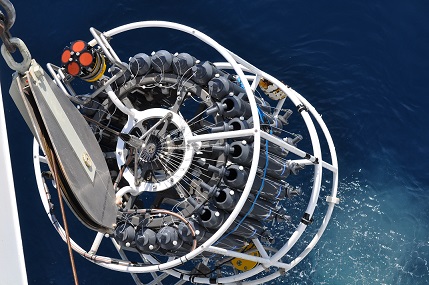 Sampling strategy
Sampling strategy
OTC coordinate and support the European network of Monitoring Stations Assembly (MSA) in the North Atlantic, Nordic Seas, Baltic and the Mediterranean. OTC cooperates with the International Ocean Carbon Coordination Project (IOCCP) to cover the global ocean observing systems, such as Voluntary Observing Ships (VOS), Fixed Ocean Stations (FOS), Repeat Ocean Sections (ROS), Marine Flux Towers (MFT) and new technologies. To constrain air-sea ocean fluxes over the entire regions such as the North Atlantic the observational data is interpolated to these regions by combining with satellite measurements of surface temperature, winds and the output of real-time ocean forecasting models.
The VOSs are usually commercial ships operating regularly repeated routes, e.g. ferry routes in European shelf and marginal seas, and cargo vessels on open ocean routes, but research vessels are also used. The FOSs are fixed sites in the ocean at which sustained time series observations are recorded by means of moorings and research ship monitoring. The ROSs are full depth sections obtained at scientific cruises, typically visited every 5 year. The MFTs are towers placed in the coastal zone measuring in air and ocean.
The VOSs and FOSs are equipped with a range of automated instrumentation to measure atmospheric and surface ocean pCO2, surface temperature, salinity and related variables. Measurements are repeateded along similar transects at intervals of days to months. The ROS measurements are performed using standard instrumentation for measuring the carbon system variables (ROS are not a fully integrated station type in ICOS, but we are working towards having these included so that we can achieve optimal monitoring). The MFT instrumentation is typically based on eddy covariance technique.
In addition to the core platforms mentioned above marine ICOS (i) works with the wider community to develop new sensors for the carbon system for autonomous platforms such as Argo floats and gliders, to provide better coverage of more remote areas, (ii) works with the hydrographic community to provide full-depth carbon observations (see below “subsurface measurements”).
Spatial coverage
Marin ICOS focuses on the North Atlantic and adjacent seas. The linear coverage along ships tracks is integrated with satellite based observations and modelled data to provide extrapolation across the surface of the ocean. The satellite data is also used to assist the interpolation of the data between passages of the ships. Carbon flux estimates are based on ships and satellite measurements of surface temperature, winds and the output of real-time ocean forecasting models.
Carbon exchange between the surface ocean and the atmosphere cannot be understood without considering the contribution to the carbon fluxes of mixing from the surface into deeper waters. Therefore ROS cooperates with:
(1) the Argo float community to ensure that information on changes in thermocline and deep water mixing are available.
(2) CLIVAR (Climate Variability and Predictability) community such as GOSHIP, to ensure that information of transport and storage of carbon within the ocean is linked with surface measurements and air-sea fluxes.
Temporal coverage
The VOSs and MFTs typically measures semi-continously, while the temporal coverage at FOSs ranges from semi-continously to anually. The ROSs are typically repated twice a decade.
